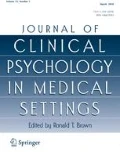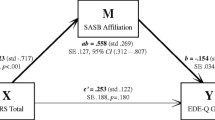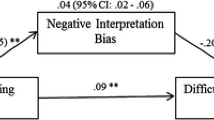Abstract
Disordered eating behaviors are often conceptualized as maladaptive emotion regulation strategies. The present study investigated links between emotional experience, schematic belief systems, and psychological themes associated with eating disorders. In contrast to the majority of studies, which focus on just one or two emotions and use nonclinical samples, this study compared the full range of emotional experience in women with eating disorders to a control group. Measures used include the Differential Emotional Scale-IV, Young’s Early Maladaptive Schema Questionnaire, and Eating Disorder Inventory-2. The study provides the first empirical evidence that women diagnosed with eating disorders report experiencing pleasant as well as unpleasant emotions more frequently than do controls. A surprising finding was that pleasant emotions (joy, interest, surprise) correlated with eating disorder themes (EDI-2 subscales) more consistently than unpleasant emotions in the eating disorder group, while the reverse was true of the control group. Also of note, eating-disordered women reported significantly less anger and similar levels of fear vs. controls. While eating-disordered women scored more highly than do controls on all maladaptive schema (suggesting high levels of distress in women with eating disorders), the pattern of correlations between schema and emotion experience was distinctly different for each group and counterintuitive for the eating disorder group. In particular, pleasant emotion was highly correlated with maladaptive schema in the eating-disordered group but not in the control group. These marked group differences in the pattern of relationships between emotion experience, eating disorder themes, and belief systems suggest that it is not valid to draw conclusions about eating disorders from research that employs only nonclinical samples. The authors discuss these findings, and suggest that women with eating disorders are proficient at using disordered eating behaviors to manipulate their experience of both positive and negative emotional states, and that this dynamic should be recognized as an important maintenance factor.
Similar content being viewed by others
References
Abraham, S. F., & Beaumont, P. J. V. (1982). How patients describe bulimia or binge eating. Psychological Medicine, 12, 625–635.
Apple, R. (1999). Interpersonal therapy for bulimia nervosa. Journal of Clinical Psychology. In session: Psychotherapy in Practice, 55(6), 715–725.
Arnow, B., Kenardy, J., & Agras, W. S. (1995). The Emotional Eating Scale: The development of a measure to assess coping with negative affect by eating. International Journal of Eating Disorders, 18, 79–90.
Bagby, R. M., Parker, J. D. A., & Taylor, G. J. (1994). The twenty-item Toronto Alexithymia Scale: I. Item selection and cross-validation of the factor structure. Journal of Psychosomatic Research, 38, 23–32.
Bagby, R. M., Taylor, G. J., & Parker, J. D. A. (1994). The twenty-item Toronto Alexithymia Scale: II. Convergent, discriminant, and concurrent validity. Journal of Psychosomatic Research, 38(1), 33–40.
Bemis, V. K., & Hollon, S. (1990). The investigation of schematic content and processing in eating disorders. Cognitive Therapy and Research, 14(2), 191–214.
Beck, A. T., & Freeman, A. M. (1990). Cognitive therapy of personality disorders. New York: Guilford Press.
Blumberg, S. H., & Izard, C. E. (1985). Affective and cognitive characteristics of depression in 10- and 11-year-old children. Journal of Personality & Social Psychology, 49(1), 194–202.
Blumberg, S. H., & Izard, C. E. (1986). Discriminating patterns of emotions in 10- and 11 yr-old children’s anxiety and depression. Journal of Personality & Social Psychology, 51(4), 852–857.
Boyle, G. J. (1984). Reliability and validity of Izard’s Differential Emotions Scale. Personality & Individual Differences, 5(6), 747–750.
Boyle, G. J. (1986). Higher -order factors in the Differential Emotions Scale (DES-III). Personality & Individual Differences, 7(3), 305–310.
Bruch, H. (1962). Perceptual and conceptual disturbances in anoreXIa nervosa. Psychosomatic Medicine, 24, 187–194.
Bruch, H. (1978). The golden cage. Cambridge: Harvard University Press.
Burney, J., & Irwin, H. J. (2000). Shame and guilt in women with eating-disordered symptomotology. Journal of Clinical Psychology, 56(1), 51–61.
Corcos, M., Guilbaud, O., Speranza, M., Patemiti, S., Loas, G., Stephan, P., (2000). Alexithymia and depression in eating disorders. Psychiatry Research, 93, 263–266.
de Groot, J., Rodin, G., & Olmsted, M. (1995). Alexithymia, depression, and treatment outcome in bulimia nervosa. Comprehensive Psychiatry, 36(1), 53–60.
de Groot, J., & Rodin, G. (1998). Coming alive: The psychotherapeutic treatment of patients with eating disorders. Canadian Journal of Psychiatry, 43, 359–366.
Fairburn, C. G. (1997). Eating disorders. In D. M. Clark & C. G. Fairburn (Eds.), Science and practice of cognitive behaviour therapy (pp. 209–241). Oxford: Oxford University Press.
Fairburn, C. G., & Cooper, Z. (1987). Behavioural and cognitive approaches in the treatment of anorexia nervosa and bulimia nervosa. In P. J. V. Beumont, G. D. Burrows, & R. C. Casper (Eds.), Handbook of anorexia nervosa and bulimia. Amsterdam: Elsevier Press.
Garner, D. M., & Bemis, K. M. (1982). A cognitive behavioural approach to anaorexia nervosa. Cognitive Therapy and Research, 6, 123–150.
Fairburn, C. G., Jones, R., Peveler, R. C., Hope, R. A., & O’Connor, M. (1993). Psychotherapy and bulimia nervosa: The longer-term effects of interpersonal psychotherapy, behaviour therapy and cognitive behaviour therapy. Archives of General Psychiatry, 50, 419–428.
Fuenzalida, C., Emde, R. N., Pannabecker, B. J., & Stenberg, C. (1981). Validation of the Differential Emotions Scale in 613 mothers. Motivation & Emotion, 5(1), 37–45.
Garner, D. M. (1991). Eating Disorders Inventory-2 Professional Manual. Odessa, FL: Psychological Assessment Resources.
Garner, D. M., & Olmstead, M. P. (1984). The Eating Disorders Inventory Manual. Odessa, FL: Psychological Assessment Resources.
Garner, D. M., Olmsted, M. P., & Polivy, J. (1983). Development and validation of a multidimensional eating disorder inventory for anorexia and bulimia. International Journal of Eating Disorders, 2, 15–34.
Geliebter, A. S., & A versa, A. (2003). Emotional eating in overweight, normal weight, and underweight individuals. Eating Behaviours, 3, 341–347.
Greenberg, L. S., & Bolger, E. (2001). An emotion-focused approach to the overregulation of emotion and emotional pain. Journal of Clinical Psychology, 57(2), 197–211.
Greenberg, L., & Paivio, S. C. (1997). Working with emotions in psychotherapy. New York: Guilford Press.
Gutwill, S., & Gitter, A. (1994). Eating problems and sexual abuse: Treatment considerations. In C. Bloom, A. Gitter, S. S. Gutwill, L. Kogel, & L. Zaphiropoulous (Eds.), Eating problems: A feminist psychoanalytic perspective (pp. 205–26). New York: Basic Books.
Hayaki, J., Friedman, M., & Brownell, K. (2002). Shame and severity of bulimic symptoms. Eating Behaviours, 3(1), 73–83.
Heatherton, T. F., & Baumeister, R. F. (1991). Binge eating as an escape from self-awareness. Psychological Bulletin, 110, 86–108.
Izard, C. E., Dougherty, F. E., Bloxom, B. M., & Kotsch, W. E. (1974). The differential emotions scale: A method of measuring the subjective experience of discrete emotions. Unpublished manuscript, Department of Psychology, Vanderbilt University.
Izard, C. E. (1971). The face of emotion. New York: Appleton-Century-Crofts.
Kearney-Cooke, A., & Striegal Moore, R. H. (1994). Treatment of childhood sexual abuse in anorexia nervosa and bulimia nervosa: A feminist psychodynamic approach. International Journal of Eating Disorders, 15, 305–319.
Lane, R. D., & Schwartz, G. E. (1987). Levels of emotional awareness: A cognitive developmental theory and its application to psychopathology. American Journal of Psychiatry, 144, 133–143.
Lee, C. W., Taylor, G., & Dunn, J. (1999). Factor structure of the schema questionnaire in a large clinical sample. Cognitive Therapy and Research, 23(4), 441–451.
Macht, M. (1999). Characteristics of eating in anger, fear, sadness and joy. Appetite, 33, 129–139.
Macht, M., & Simons, G. (2000). Emotions and eating in everyday life. Appetite, 35, 65–71.
McManus, F., & Waller, G. (1995). A functional analysis of binge eating. Clinical Psychology Review, 15(8), 845–863.
Meyer, C., Waller, G., & Waters, A. (1998). Emotional states and bulimic psychopathology. In H. Hoek, J. Treasure, & M. Katzman (Eds.), The integration of neurobniology in the treatment of eating disorders (pp. 271–289). Chichester: Wiley.
Milligan, R., & Waller, G. (2000). Anger and bulimic psychopathology among nonclinical women. International Journal of Eating Disorders, 28, 446–450.
Polivy, J., & Herman, C. P. (2002). Causes of eating-disorders. Annual Review of Psychology, 53(1), 187–213.
Rizzuto, A. M. (1988). Transference, language, and affect in the treatment of bulimarexia. International Journal of Psychoanalysis, 69, 369–387.
Serpell, L., Treasure, J., Teasdale, J., & Sullican, V. (1999). Anorexia nervosa: Friend or foe. International Journal of Eating Disorders, 25, 177–186.
Schmidt, N. R., Joiner, T. E., Young, J. E., & Telch, M. J. (1995). The schema questionnaire: Investigation of psychometric properties and the hierarchical structure of a measure of maladaptive schemas. Cognitive Therapy and Research, 19(3), 295–321.
Taylor, G., Parker, J., Bagby, M., & Bourke, M. (1996). Relationships between alexithymia and psychological characteristics associated with eating disorders. Journal of Psychosomatic Research, 41(6), 561–568.
Thompson, R. A. (1990). Early attachment and later development. In R. A. Thompson (Ed.), Socioemotional Development. Nebraska Symposium on Motivation (Vol. 36, pp. 367–467). Lincoln: University of Nebraska Press.
Vitousek, K. (1996). The current status of cognitive-behavioural models of anorexia nervosa and bulimia nervosa. In P. M. Salkovskis (Ed.), Frontiers of cognitive therapy (pp. 383–418). New York: Guilford Press.
Vitousek, K., & Ewald, I. (1993). Self representation in eating disorders: A cognitive perspective. In Z. Segal & S.Blatt (Eds.), The self in emotional disorders (pp 221–257). New York: Guilford Press.
Vitousek, K., & Watson, S. (1998). Enhancing motivation for change in treatment resistant eating disorders. Clinical Psychology Review, 18(4), 391–420.
Waller, G., Ohanian, V., Meyer, C., & Osman, S. (2000). Cognitive content among bulimic women: The role of core beliefs. International Journal of Eating Disorders, 28(2), 235–241.
Waller, G., Meyer, C., & Ohanian, V. (2001). Psychometric properties of the long and short versions of the Young Schema Questionnaire: Core beliefs among bulimic and comparison women. Cognitive Therapy & Research, 25(2), 137–147.
Waller, G., Shah, R., Ohanian, V., & Elliott, P. (2001). Core beiiefs in bulimia nervosa and depression: The discriminant validity of Young’s Schema Questionnaire. Behavior Therapy, 32(1), 139–153.
Young, J. E. (1994). Cognitive therapy for personality disorders: A schema-focused approach (Rev. ed.). Sarasota, FL: Professional Resource Press.
Author information
Authors and Affiliations
Rights and permissions
About this article
Cite this article
Overton, A., Selway, S., Strongman, K. et al. Eating Disorders—The Regulation of Positive as well as Negative Emotion Experience. J Clin Psychol Med Settings 12, 39–56 (2005). https://doi.org/10.1007/s10880-005-0911-2
Issue Date:
DOI: https://doi.org/10.1007/s10880-005-0911-2




